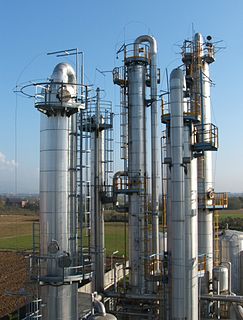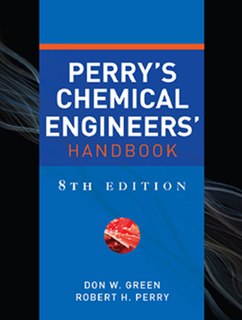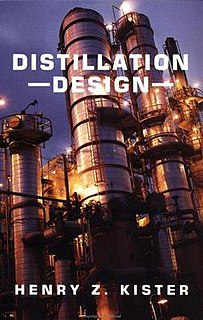
Chemical engineering is a branch of engineering that uses principles of chemistry, physics, mathematics, biology, and economics to efficiently use, produce, design, transport and transform energy and materials. The work of chemical engineers can range from the utilisation of nano-technology and nano-materials in the laboratory to large-scale industrial processes that convert chemicals, raw materials, living cells, microorganisms, and energy into useful forms and products.

Mechanical engineering is an engineering branch that combines engineering physics and mathematics principles with materials science to design, analyze, manufacture, and maintain mechanical systems. It is one of the oldest and broadest of the engineering branches.

Environmental engineering is a professional engineering discipline that takes from broad scientific topics like chemistry, biology, ecology, geology, hydraulics, hydrology, microbiology, and mathematics to create solutions that will protect and also improve the health of living organisms and improve the quality of the environment. Environmental engineering is a sub-discipline of civil engineering, chemical engineering and mechanical engineering.

Paper engineering is a branch of engineering that deals with the usage of physical science and life sciences in conjunction with mathematics as applied to the converting of raw materials into useful paper products and co-products. The field applies various principles in process engineering and unit operations to the manufacture of paper, chemicals, energy and related materials. The following timeline shows some of the key steps in the development of the science of chemical and bioprocess engineering:

In the field of engineering, a chemical engineer is a professional, equipped with the knowledge of chemical engineering, who works principally in the chemical industry to convert basic raw materials into a variety of products and deals with the design and operation of plants and equipment. In general, a chemical engineer is one who applies and uses principles of chemical engineering in any of its various practical applications; these often include
- design, manufacture, and operation of plants and machinery in industrial chemical and related processes ;
- development of new or adapted substances for products ranging from foods and beverages to cosmetics to cleaners to pharmaceutical ingredients, among many other products ; and
- development of new technologies such as fuel cells, hydrogen power and nanotechnology, as well as working in fields wholly or partially derived from chemical engineering such as materials science, polymer engineering, and biomedical engineering.
Process engineering is the understanding and application of the fundamental principles and laws of nature that allow us to transform raw material and energy into products that are useful to society, at an industrial level. By taking advantage of the driving forces of nature such as pressure, temperature and concentration gradients, as well as the law of conservation of mass, process engineers can develop methods to synthesize and purify large quantities of desired chemical products. Process engineering focuses on the design, operation, control, optimization and intensification of chemical, physical, and biological processes. Process engineering encompasses a vast range of industries, such as agriculture, automotive, biotechnical, chemical, food, material development, mining, nuclear, petrochemical, pharmaceutical, and software development. The application of systematic computer-based methods to process engineering is "process systems engineering".

In chemical engineering and related fields, a unit operation is a basic step in a process. Unit operations involve a physical change or chemical transformation such as separation, crystallization, evaporation, filtration, polymerization, isomerization, and other reactions. For example, in milk processing, homogenization, pasteurization, and packaging are each unit operations which are connected to create the overall process. A process may require many unit operations to obtain the desired product from the starting materials, or feedstocks.

A chemical plant is an industrial process plant that manufactures chemicals, usually on a large scale. The general objective of a chemical plant is to create new material wealth via the chemical or biological transformation and or separation of materials. Chemical plants use specialized equipment, units, and technology in the manufacturing process. Other kinds of plants, such as polymer, pharmaceutical, food, and some beverage production facilities, power plants, oil refineries or other refineries, natural gas processing and biochemical plants, water and wastewater treatment, and pollution control equipment use many technologies that have similarities to chemical plant technology such as fluid systems and chemical reactor systems. Some would consider an oil refinery or a pharmaceutical or polymer manufacturer to be effectively a chemical plant.
In chemical engineering, process design is the choice and sequencing of units for desired physical and/or chemical transformation of materials. Process design is central to chemical engineering, and it can be considered to be the summit of that field, bringing together all of the field's components.
Chemical engineering is a discipline that was developed out of those practicing "industrial chemistry" in the late 19th century. Before the Industrial Revolution, industrial chemicals and other consumer products such as soap were mainly produced through batch processing. Batch processing is labour-intensive and individuals mix predetermined amounts of ingredients in a vessel, heat, cool or pressurize the mixture for a predetermined length of time. The product may then be isolated, purified and tested to achieve a saleable product. Batch processes are still performed today on higher value products, such as pharmaceutical intermediates, speciality and formulated products such as perfumes and paints, or in food manufacture such as pure maple syrups, where a profit can still be made despite batch methods being slower and inefficient in terms of labour and equipment usage. Due to the application of Chemical Engineering techniques during manufacturing process development, larger volume chemicals are now produced through a continuous "assembly line" chemical processes. The Industrial Revolution was when a shift from batch to more continuous processing began to occur. Today commodity chemicals and petrochemicals are predominantly made using continuous manufacturing processes whereas speciality chemicals, fine chemicals and pharmaceuticals are made using batch processes.
Transport Phenomena is the first textbook about transport phenomena. It is specifically designed for chemical engineering students. The first edition was published in 1960, two years after having been preliminarily published under the title Notes on Transport Phenomena based on mimeographed notes prepared for a chemical engineering course taught at the University of Wisconsin–Madison during the academic year 1957-1958. The second edition was published in August 2001. A revised second edition was published in 2007. This text is often known simply as BSL after its authors' initials.

Perry's Chemical Engineers' Handbook was first published in 1934 and the most current ninth edition was published in July 2018. It has been a source of chemical engineering knowledge for chemical engineers, and a wide variety of other engineers and scientists, through seven previous editions spanning more than 70 years.

Distillation Design is a book which provides complete coverage of the design of industrial distillation columns for the petroleum refining, chemical and petrochemical plants, natural gas processing, pharmaceutical, food and alcohol distilling industries. It has been a classical chemical engineering textbook since it was first published in February 1992.
The following outline is provided as an overview of and topical guide to chemical engineering:
The University of Santo Tomas Faculty of Engineering, or UST-Eng'g, is the engineering school of the University of Santo Tomas, the oldest and the largest Catholic university in Manila, Philippines.

Benson Hall is a building in the University of Washington campus. It is home to the chemical engineering department. The building was named after Henry K. Benson, a faculty member from 1904 to 1954. During this time, he held the position of Chair of Chemistry and Chemical Engineering. Leonard William Bindon and John LeBaron Wright designed Benson Hall.

Project commissioning is the process of assuring that all systems and components of a building or industrial plant are designed, installed, tested, operated, and maintained according to the operational requirements of the owner or final client. A commissioning process may be applied not only to new projects but also to existing units and systems subject to expansion, renovation or revamping.
Thomas Flynn Edgar is an American chemical engineer. He is member of the National Academy of Engineering and the George T. and Gladys H. Abell Chair in Chemical Engineering at the University of Texas at Austin.

Gilbert F. Froment is professor emeritus of chemical engineering at the University of Gent, Belgium, and research professor of Texas A&M University. Froment's career and influence bridges the gap between academic kinetic and chemical reaction engineering studies, and application of that fundamental science to problems of industrial relevance.

Ernest W. Thiele (1895–1993) was an influential chemical engineering researcher at Standard Oil and Professor of Chemical Engineering at the University of Notre Dame. He is known for his highly impactful work in chemical reaction engineering, complex reacting systems, and separations, including distillation theory.












